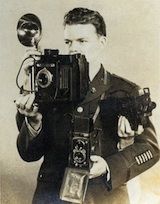- Forum
- Photography and Camera Forum
- Equipment Research, Buying and Using
- Lenses
- Question about Tamron 60mm lens...
Question about Tamron 60mm lens...
Post #81171
"The Tamron SP AF60mm F/2.0 Di II LD 1:1 Macro (model G005) is the industry’s first medium telephoto macro lens designed for APS-C size digital SLR cameras that features a fast maximum aperture of F/2.0—one stop faster than the F/2.8 maximum aperture found on conventional macro lenses in the same class. The SP AF60mm F/2.0 covers an equivalent angle of view of 93mm when converted to the 35mm format. "
This seems to be in direct contradiction to what I understand about the crop ratio of an APS-C sensor. What am I missing here?
Reference: cgi.ebay.com/Tamron-SP-AF-60mm-F2-Di-II-...65026#ht_2655wt_1138
“Amateurs worry about equipment, professionals worry about money, masters worry about light, I just make pictures… ” ~ Vernon Trent
-

- Johnnie
- Photography Hooked
-
- Canon 7D, Canon 20D, Fujifilm Finepix S1000fd
- Followers: 146
- Posts: 887
-
Points:
2
Post #81185
A good explanation of Full Frame vs APS-C with the conversion factors given. I am totally confused with all of the conversions other than I know that I have 1.6 Crop Canon Camera. So all I do is mulitply. Good luck my friend.
-

- MLKstudios
- Banned
-
- D800 ;-)
- Followers: 72
- Posts: 4480
-
Points:
2
Post #81321
On a Nikon DX the 60mm becomes a 90mm, which allows you work a bit further back than a 60mm on a full frame. If the lens can do 1:1 full frame, then that is also cropped by the sensor it equals something greater than 1:1.
Did that answer the question?
Matthew
Matthew L Kees
MLK Studios Photography School
www.MLKstudios.com
[email protected]
"Every artist, was once an amateur"
Post #81399
Here is the question - more to the point - "The Tamron SP AF60mm F/2.0 Di II LD 1:1 Macro (model G005) is the industry’s first medium telephoto macro lens designed for APS-C size digital SLR cameras". Does this mean it will be like a 60mm lens on my APS-C camera or more like a 90+mm?
Secondarily, would this make a good alternative to a 50mm f/1.4 or f/1.8?
“Amateurs worry about equipment, professionals worry about money, masters worry about light, I just make pictures… ” ~ Vernon Trent
-

- MLKstudios
- Banned
-
- D800 ;-)
- Followers: 72
- Posts: 4480
-
Points:
2
Post #81403
And yes, it would be a good alternative if you like to get in close. A 50mm would give you the same field of view of a 75mm lens, so it is only slightly more "telephoto".
Matthew
PS my guess is that it doesn't cover a full frame chip (or film frame) and is why they say "designed for APS-C".
Matthew L Kees
MLK Studios Photography School
www.MLKstudios.com
[email protected]
"Every artist, was once an amateur"
-

- MLKstudios
- Banned
-
- D800 ;-)
- Followers: 72
- Posts: 4480
-
Points:
2
Post #81411
Don't know why I was thinking you were Nikon. The Canon 1.6x factor adds those extra 3mm, and makes the 50mm closer to the field of view of an 80mm lens.
Matthew
Matthew L Kees
MLK Studios Photography School
www.MLKstudios.com
[email protected]
"Every artist, was once an amateur"
- Forum
- Photography and Camera Forum
- Equipment Research, Buying and Using
- Lenses
- Question about Tamron 60mm lens...
Latest Reviews
The Fujifilm XT5 is a 40MP mirrorless camera capable of 6.2K video at 30p. With those specs, it’s an ideal choice for photographers needing a camera to pull double duty for imaging and video.
The Canon EOS R100 is an entry-level mirrorless camera introduced in 2023. But just because it’s an entry-level camera doesn’t mean it’s a bare-bones camera. Find out why in this review!
Nikon’s retro-looking Nikon Zfc is anything but retro. Under its classic body is a host of features and amenities that make it a worthwhile compact mirrorless camera for 2024.
The Canon EOS R50 is one of the newest R-system cameras from Canon. Is it worth your money? Find out all the details you need to know in this comprehensive review.
Latest Articles
To fill the frame means to expand the footprint of the subject in your shot. Get in close, zoom in, crop the image, or use other techniques to bring the subject to the forefront.
With these simple yet effective beginner photography tips, you can avoid some of the common mistakes beginners make and get improved results with your images.
Urban photography is a genre showcasing features in urban settings. You can photograph people, architecture, mass transit, and many other subjects. Learn how to do so in this guide!
The Nikon D850 might be an older DSLR, but it was ahead of its time when it debuted in 2017. That means it still has plenty of firepower to compete with today’s powerful mirrorless cameras.
The best beginner camera isn’t the same for everyone. That means having choice is of the utmost importance. In this guide, explore five excellent beginner camera options for 2024 and beyond.
Child portrait photography is a unique undertaking requiring special skills and talents to get the best results. Start mastering this photography niche with these essential tips!
The Fujifilm XT5 is a 40MP mirrorless camera capable of 6.2K video at 30p. With those specs, it’s an ideal choice for photographers needing a camera to pull double duty for imaging and video.
Using leading lines in photography helps improve the composition by drawing viewers in and leading their eye from the foreground to the background. Explore some fine examples of this in this guide!














